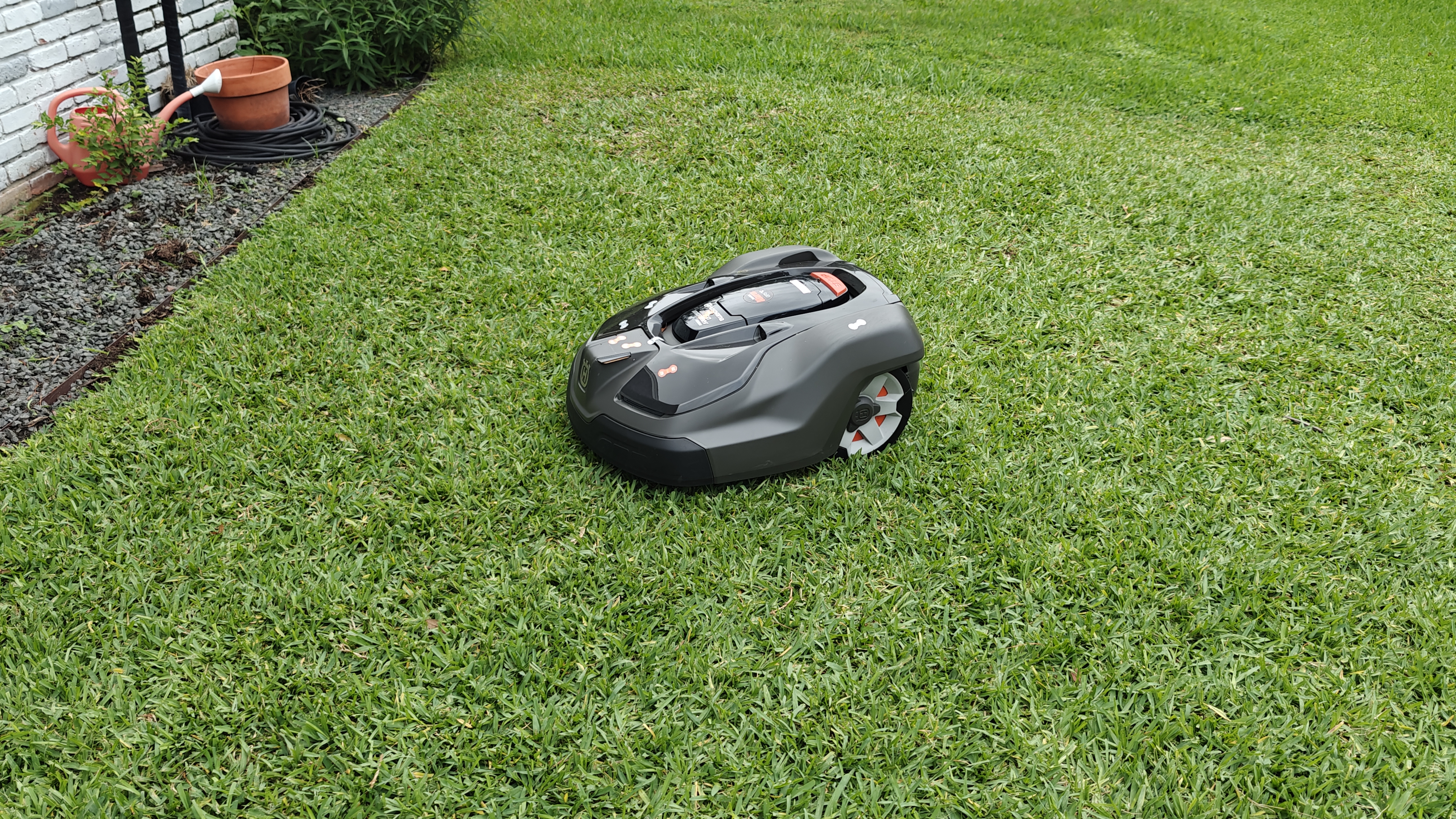
Summertime is here, which means regular lawn care and maintenance is in full swing. And if you live in a hotter part of the world, keeping you grass trim and healthy takes a lot of work (and sweat). Where I live in South Texas, we often have to cut the grass multiple times a week. So either I’m stuck doing it myself or paying someone else to do it from my ever-dwindling paycheck.
While I don’t necessarily mind mowing the grass myself, especially using one the best lawn mowers out there, having something like the Husqvarna Automower 450XH has been a huge help for keeping my lawn nice and healthy. I simply schedule it to cut at the days and times I want, then it goes and does it’s thing without me having to lift a finger. Whether I’m at the coffee shop, running errands, or sitting in my nice air-conditioned home, it just does it’s thing every day and does a pretty bang up job to boot.
Unfortunately, as long as they continue to be made by humans, even the best robot lawn mowers won’t be perfect, and neither is the Automower 450XH. It doesn’t completely remove the burden of lawn care from my shoulders and it can be tricky to setup and get support for. Coupled with the $3,299 price tag, is it worth it? Let’s find out.
Husqvarna Automower 450XH: First Impressions
The Husqvarna Automower 450XH arrived in a box that was much bigger than I expected. I wasn’t necessarily expecting it to be small, but it was still bigger than I imagined. Part of the reason for that is I was also sent the large size installation kit along with it. The size of installation kit you need depends on the size of your lawn.
The box with the mower itself includes the mower, charging pad, power brick, connector cable, ground screws for the charging pad, replacement blades, and some stickers to help with installation. There was about a 70/30 split between cardboard and plastic in the box. The mower itself was wrapped in bubble wrap and several of the accessories came packaged in plastic bags. I get why they package all the accessories separately for shipping, but they could have used the more sustainable materials you see nowadays.
The large installation kit—suited for yards up to about 54,000 ft2 (5000 m2)—had the most plastic. There we six bags of plastic stakes, two shrink-wrapped spools of wire, and a small bag of wire connectors.
Husqvarna Automower 450XH: Price & availability
The Automower 450XH that I’ve reviewed here runs a cool $3,299.99 (at press time it’s on sale for $2,639.99) which certainly puts it towards the top of the range for robot mowers. It can be bought from Amazon, Husqvarna, or your local dealer.
Husqvarna has a few other models in their 400 line including the 415X, 430X, 430XH, and 450X ranging from $1,999 to the $3,299 for the 450XH. The only major difference in these models is the size of yard they are rated for ranging from 0.37, 0.8, and 1.25 acre lawns respectively.
Regarding the 430 and 450 series, the only difference between the ‘X’ and the ‘XH’ models is the cutting height. The "X" models cut between 0.8 and 2.4 inches while the XH models cut between 2.0 and 3.5 inches.
If you have some fairly significant slopes in your yard, they have a 435X AWD model with much more aggressive wheels that can accommodate up to 70% slopes. For the smaller yards or for folks who don’t need as many fancy features, you can check out the 115H for a much more affordable $699.
Lastly, they do offer what they call an EPOS version of the 450X and 450XH. We haven’t had a chance to test it, but the major difference is that it supposedly doesn’t need a boundary wire and can operate entirely within virtual boundaries. This also enables it to cut up to 2.5 acre yards, but it also costs almost double at $5,899.
Husqvarna Automower 450XH: Design
The Husqvarna Automower 450XH sort of looks a miniaturized version of a car from a sci-fi film or even a droid straight out of Star Wars. Around front it has two little headlight bars, a hard rubber front bumper so it doesn’t damage itself or anything else it might bump into, and a little nose that sticks up where it attaches to the charging pad.
On top there are a couple of sensors and a big red STOP button that immediately stops the mower and opens up the control panel. The control panel is where you can manually click through the menu and setting options and where you input your pin code if you choose to use one (you should). The pin code is required anytime the control panel is opened which is helpful if you’ve cut curious kiddos or if someone tries to walk off with it – more on the anti-theft features in a bit.
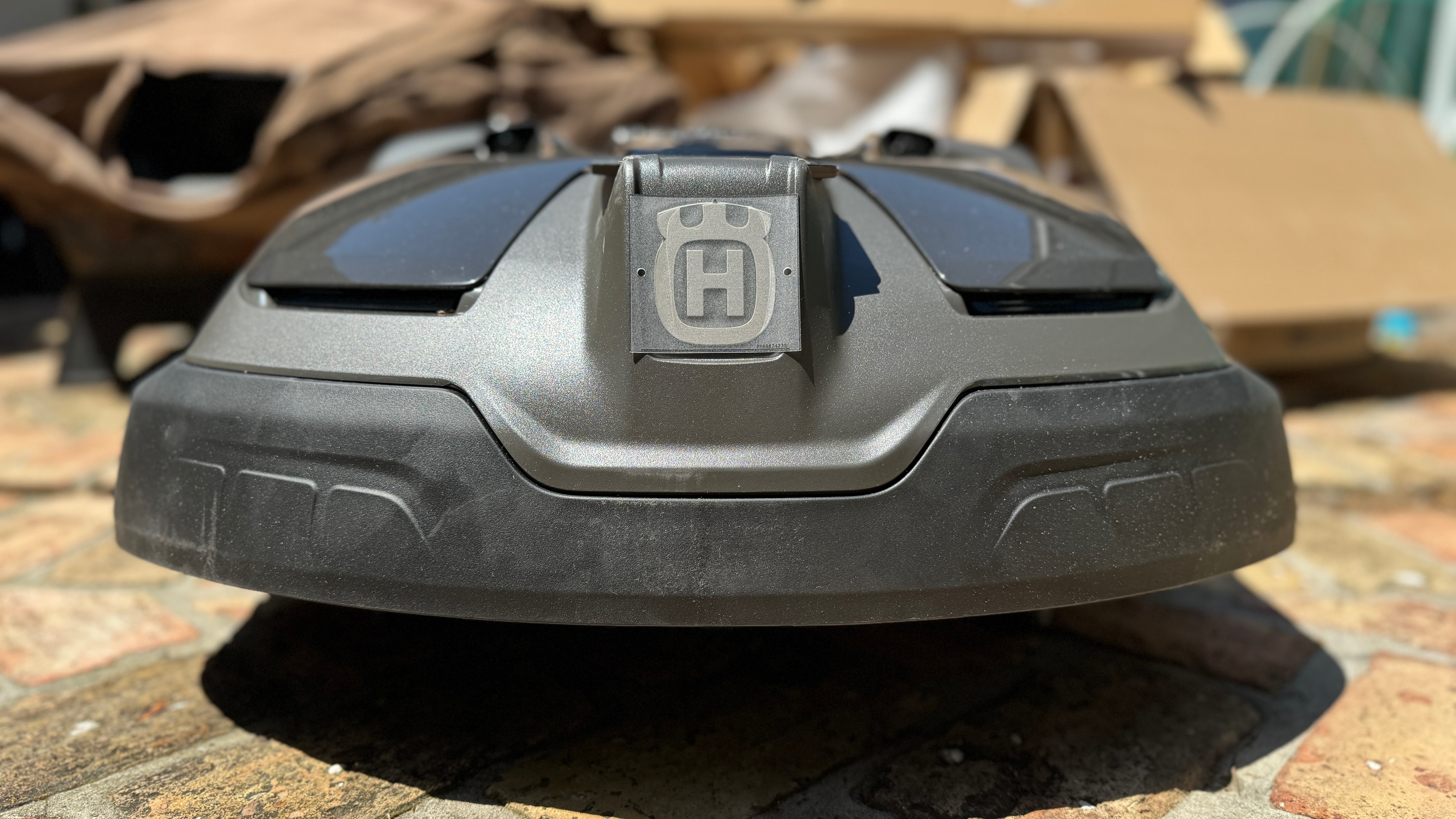
While it is a bit larger than I was expecting, it’s not unwieldy or unmanageable. In fact, there’s a little handhold under the back of the cover if you ever need to pick it up. It weighs just under 34 pounds and measures 30 x 25 x 13in ( l x w x h). I was grateful that it actually doesn’t stand out as much in my yard as I thought, but it’s noticeable enough that I’ve definitely become the most popular guy in the neighborhood with someone asking me about it at least every other day.
It comes in gray, but you can purchase other hoods for it in white or Husqvarna orange.
Underneath the mower are the cutting blades. There are three razor blades that spin around on a circular disk designed to cut just a few millimeters off your grass every day. The clippings drop back into the grass which helps fertilize your lawn and keep it healthy.

I was somewhat surprised by how vastly different the size of front and rear wheels are. The front wheels look like wheels your mind find on an office cart while the back wheels are much more aggressive look like tiny tractor wheels.
Score: 5 out of 5
Husqvarna Automower 450XH: Key specs
Husqvarna Automower 450XH: Setup
One of the biggest downsides to many robot mowers these days is the significant amount of setup required to get them up and running. In fact, nearly every major robot mower manufacturer recommends going through a dealer for purchase, delivery, and setup, largely for that reason.
However, it is perfectly possible to do it yourself. It’s really not that hard, it’s just tedious and takes a while (which is my guess as to why most people don’t want to do it themselves). The total setup time required depends largely, of course, on the size of your yard, but once you get the hang of it, it’s pretty simple and Husqvarna includes pretty much everything you need to do it, along with good instructions.
Pro tip: I highly recommend sketching out your lawn first just to give yourself a visual idea of what you’ll need to do. Make note of any elements in your yard (trees, garden beds, etc.) and also look for where you’ll want to place the guide wire(s). Husqvarna recommends placing the guide wire as close to the opposite side of your yard from the charging pad as you can. You can also place them in areas that might be hard to get to in your yard.
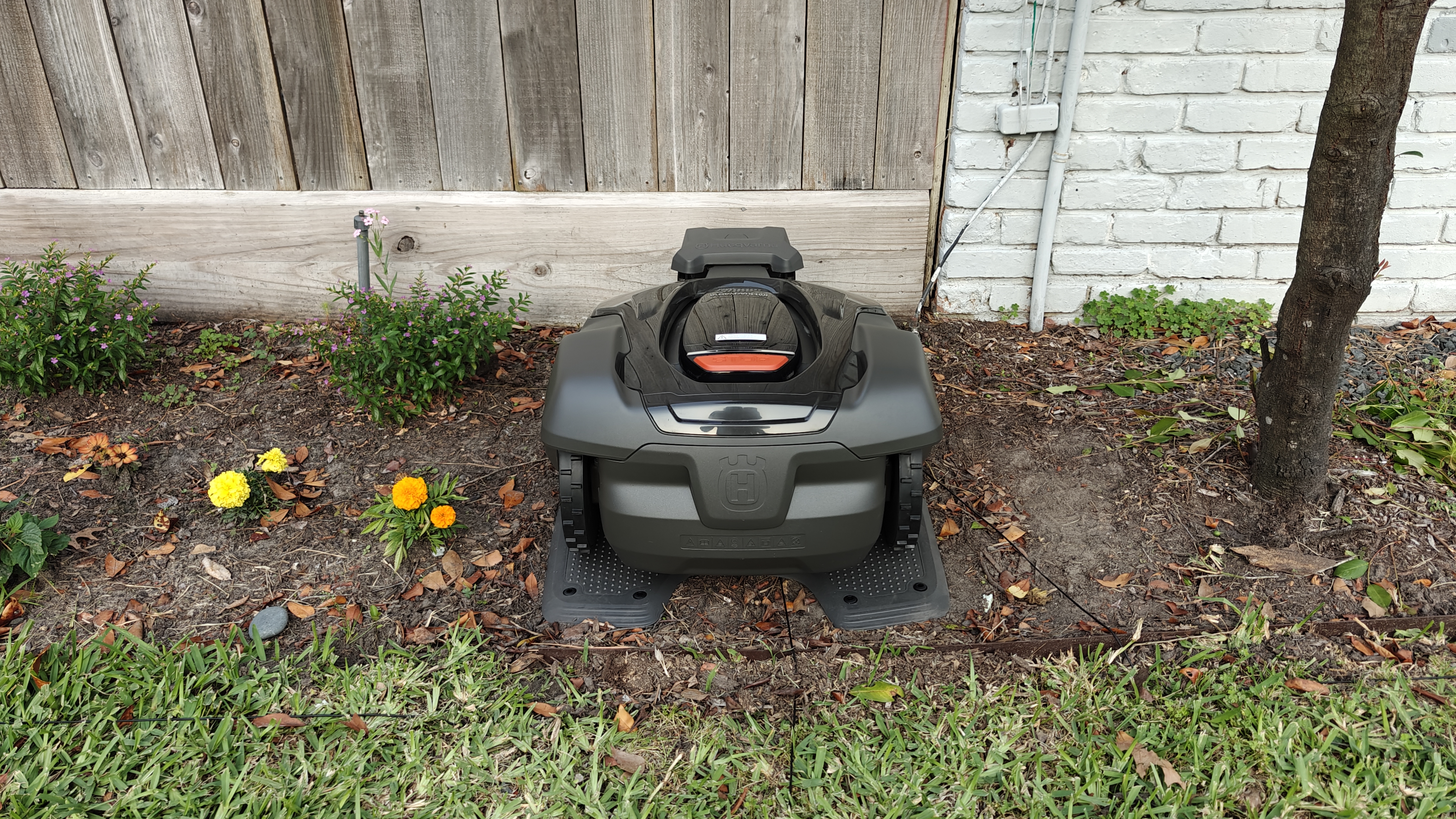
The trickiest part of the initial setup for me was simply finding a place to put the dang thing. I was hoping to try to tuck it away somewhere where it wouldn’t be too obvious, but I couldn’t end up putting it where I wanted for a couple of reasons. There’s a power brick that plugs into a regular outlet, but the cord for it is pretty short and they recommend putting the power brick under a covered area, so that was the first limiting factor.
Secondly, there’s a proprietary power cord that runs from the brick to the charging station which is only about 20 feet long. You can buy an extension for it if you want to, but I did not. Anyway, once I found a spot for it to live, I actually didn’t mind it too bad. It doesn’t stand out as much as I thought it would and it ended up in the part of the yard that needs the most maintenance anyway.
Once you’ve got the charging pad where you want it, don’t secure it down just yet. Grab a spool of wire and start by making yourself a little loop of about three or four feet and stake it down to hold it in place. Then, start unrolling the wire out away from the charging pad. Note: don’t connect any of the couplers to the charging pad yet. Wait until you’ve got everything in place before connecting it.
Husqvarna doesn’t recommend bringing the boundary wire out in front of the charging pad, instead going out directly to the side. However, I ended up having to do that due to where my charging pad was placed, and it hasn’t affected anything so far.
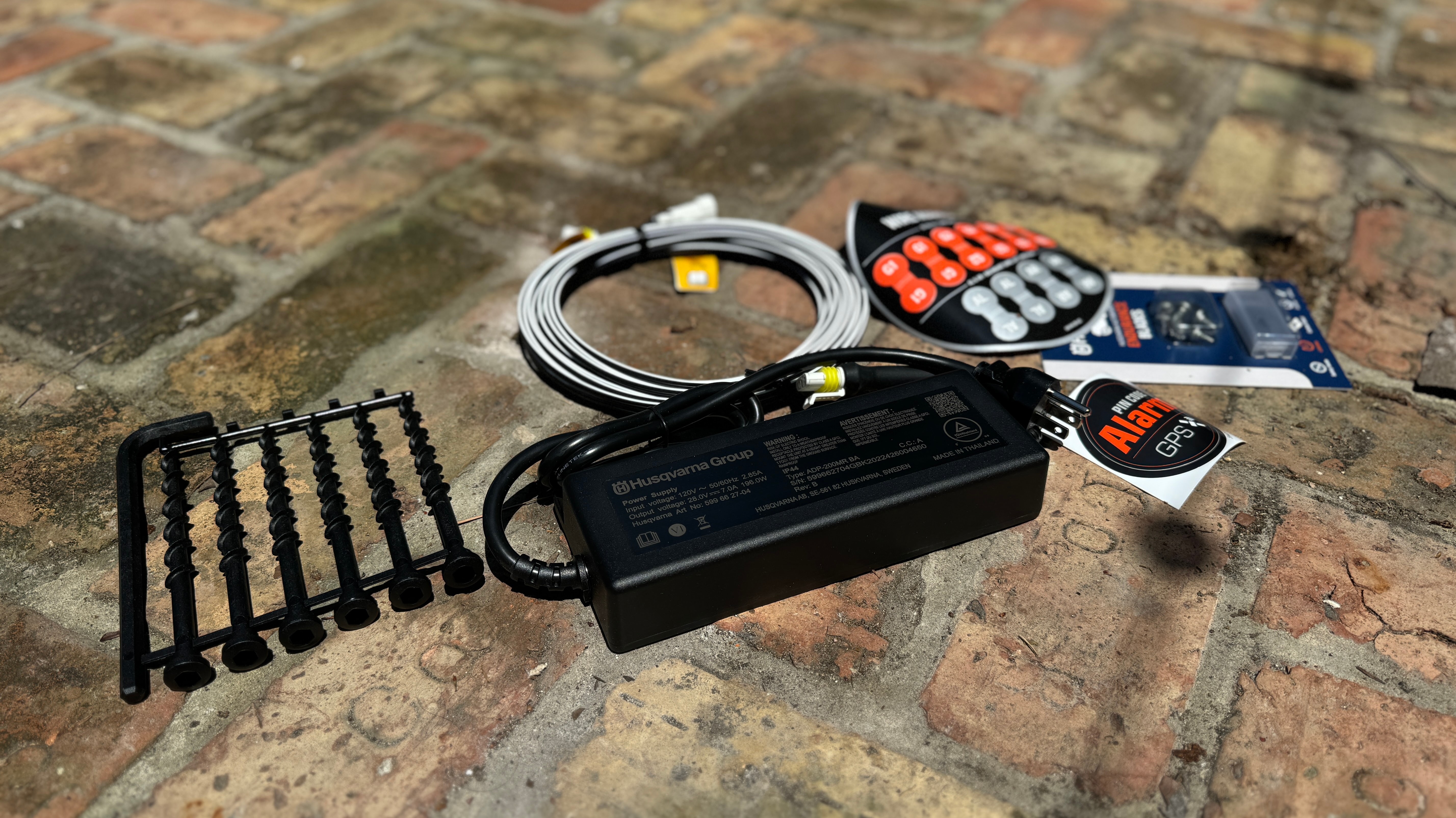
Depending on the type of boundary around your yard, you’ll need to lay the boundary wire at different distances from it to avoid damaging the Automower (we named ours Rover):
- Walls higher than 2 feet: 16 in. from the wall
- Walls lower than 2 feet: 10 in. from the wall
- Level ground: 4 in. from the edge
Helpfully, Rover’s box had two cardboard rulers inserted into it that were very helpful in measuring how far from the edge I needed to keep the boundary wire. As you go along, Husqvarna recommends placing a stake about every 30 inches.
First things first, you’ll need to make a note of where you want to put the guide wire(s). Maybe place a stick or yard flag in the approximate spot so you won’t forget (like me).
Before you start running your boundary wire, take note of the elements in your yard. If you have a few trees with no beds or barriers around them, Rover can simply roll up to them and redirect himself away. If you’ve got garden beds surrounding the trees, you’ll need to make an ‘island’ with the boundary wire.
As you go around the edge of yard, once you’re perpendicular to the element you need to go around, make a 90 degree turn and go straight up towards the element. Then, once you’re about four to six inches away, go in a circle around the element, staking the wire down every few inches. Once you get all the way around, follow the wire back out to the edge.
Note: be sure to lay the wires next to or directly on top of each other. If they cross over each other, the Husqvarna Automower 450XH won’t be able to cross over it.
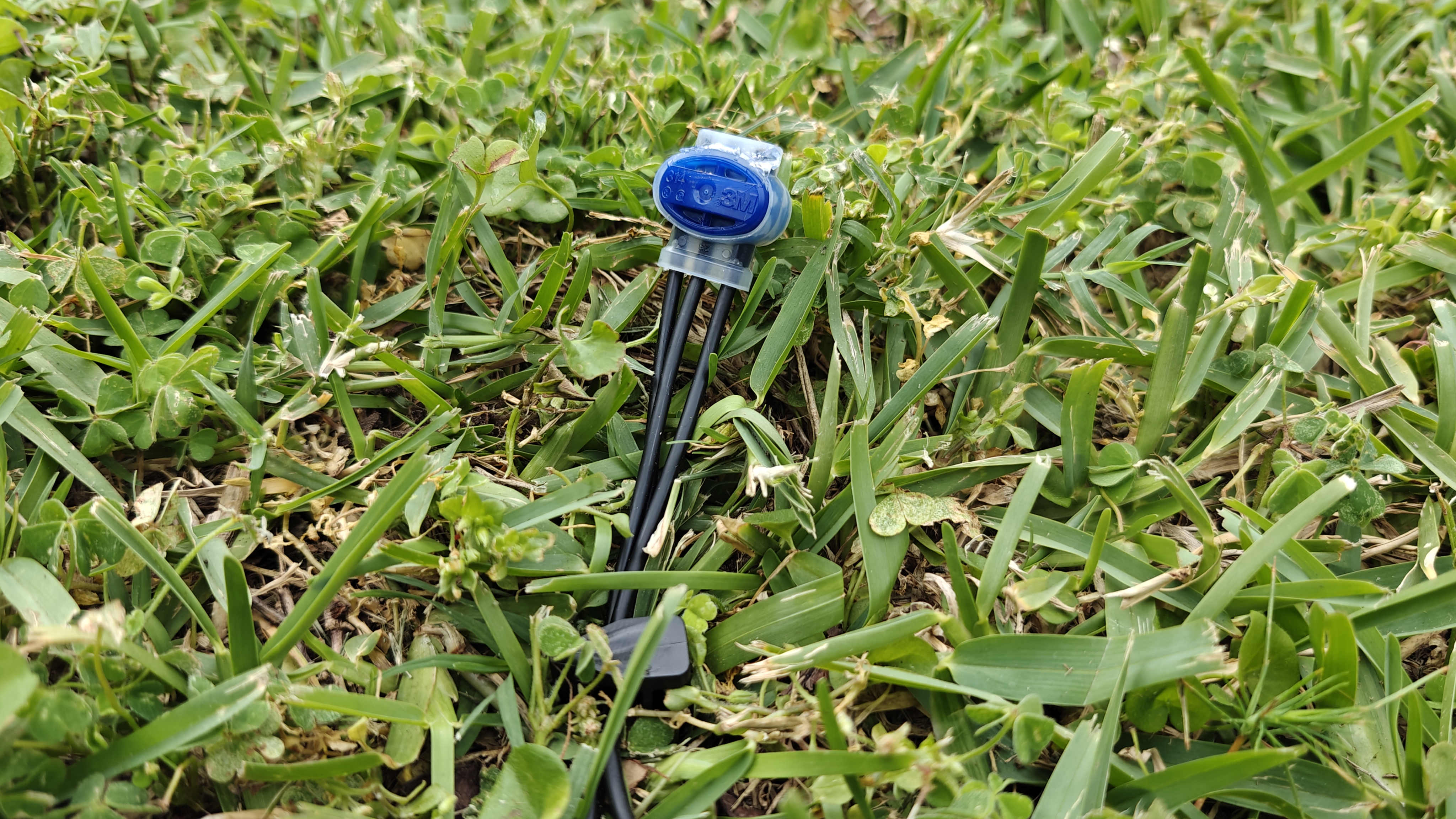
Overall, while the setup is not unusually difficult, it is quite time consuming, which is a bit frustrating, especially these days when robot mowers, like the fantastic Segway Navimow i105N (and even Husqvarna’s own mowers), can work without the need for wires at all.
When you hit the spot where your guide wire will go, cut the wire and grab one of the blue and silver couplers. Insert the end into one of the three of the three holes with the other end in one of the other holes (apparently it doesn’t matter which holes you place the wires in, but my OCD would only let me put them in order). Finally, insert the guide wire into the remaining hole, use pliers to crimp down the coupler, and bury it under the grass.
Finish laying the boundary wire, then come back and run the guide wire back to the charging station. It’s best to go straight out from the boundary wire as far as you can, then make the turn back to the charging station at 45 degree angles. Be sure to leave yourself a couple of extra feet at the end.
Now, using the maroon couples, you can connect the ends of each wire to the charging pad. If you did everything correctly, the little LED light on the back of the charging pad should be green. If you see blue, you’ll need to check it again.
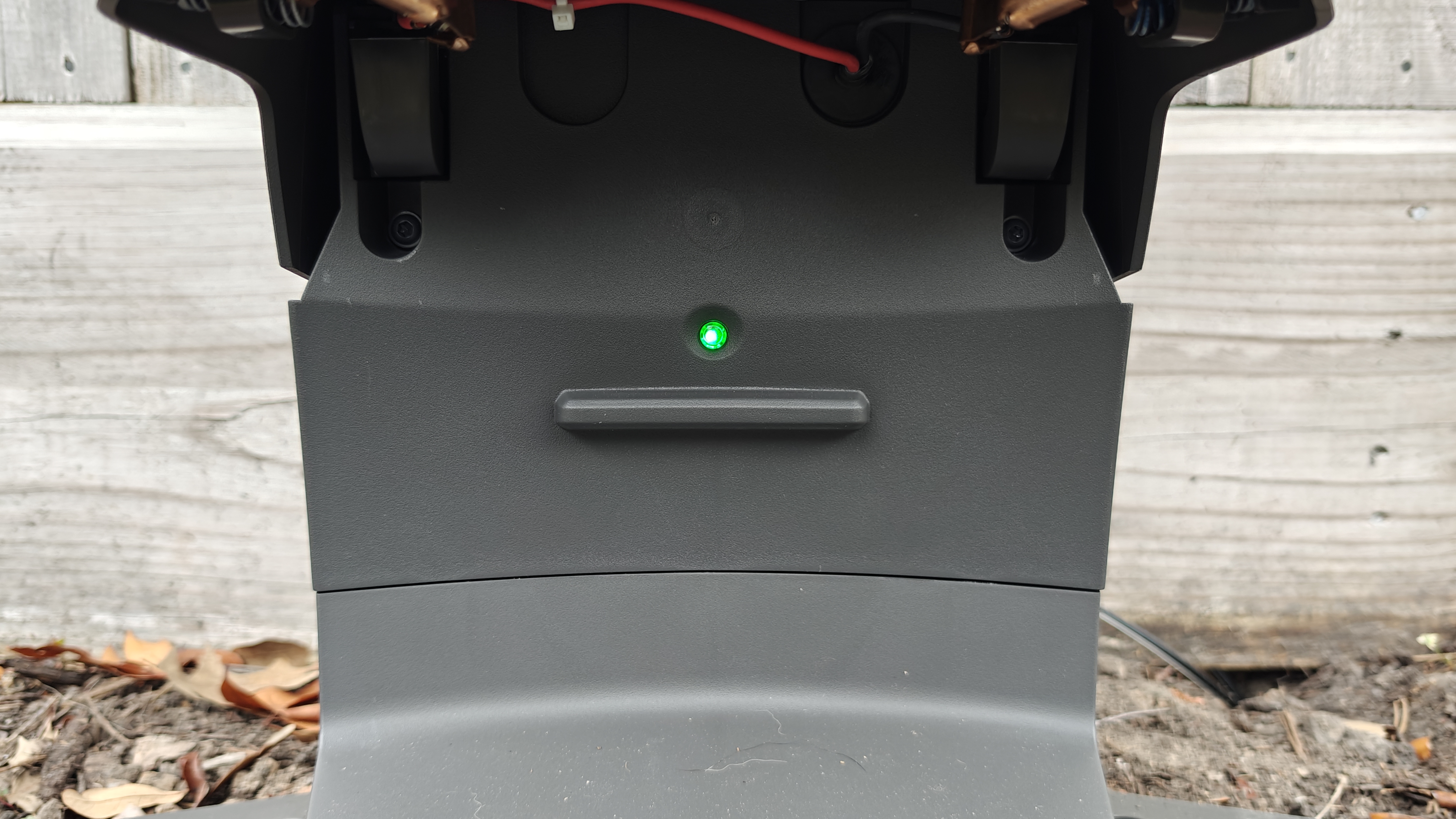
Ok, but what if you have a divided yard, say by a front walk or a driveway? Great question. You basically can just lay the boundary into the joists of your sidewalk or driveway, and Rover will roll right over it without thinking twice. And don’t, worry, as long as it’s level with the grass, he won’t damage his blades or anything.
Alternatively, you can make a small corridor with the boundary wire by running them just a few feet apart and place a guide wire between them, so Rover knows exactly where to cross.
Once you’ve spent a couple of weeks tweaking your boundary wire and making sure everything’s running smoothly, I highly recommend burying the boundary wire. You can put it up a few inches underground so you never have to worry about cutting it or anything else getting caught up in it and it will still work just fine.
Whew, that’s a lot, but remember the idea is, once you set it up, you’ll never have to mess with it again. Husqvarna has plenty of great resources to help with installation as well if you need some extra help.
Pro tip: it’s a good idea to check on the boundary wire after a couple of weeks of use as I found a few places that had loosened up and needed to add a few extra stakes.
Overall, while the setup is not unusually difficult, it is quite time consuming, which is a bit frustrating, especially these days when robot mowers, like the fantastic Segway Navimow i105N (and even Husqvarna’s own mowers), can work without the need for wires at all.
Score: 3 out of 5
Husqvarna Automower 450XH: Performance
All-in-all the Automower 450XH was quite impressive. I intentionally left a part of my yard outside the boundary of the 450XH because I wanted to see how it maintained the yard over time and it did a phenomenal job. Over several weeks, I had the mower run for approximately four hours every day and it was nearly perfect.
Promptly at 9AM every morning, it would back itself off the charging pad and proceed to roll back and forth across the yard. When it hit a boundary wire, it would back up a few inches, turn and head off in another direction. When it was finished, it would roll across the mow area until it hit the guide wire, the make its way back home for the rest of the day. Rain or shine, Rover would do his thing without complaint.
The first couple of days, I was a bit nervous about how well he would do, but after about a week, I haven’t given that part of the yard a second thought. The grass looks great and I haven’t had to do hardly anything. He was also able to cut the 1,250 square foot mow area in my yard for the entire four hour time span and would end each day with about 15% battery life to spare.
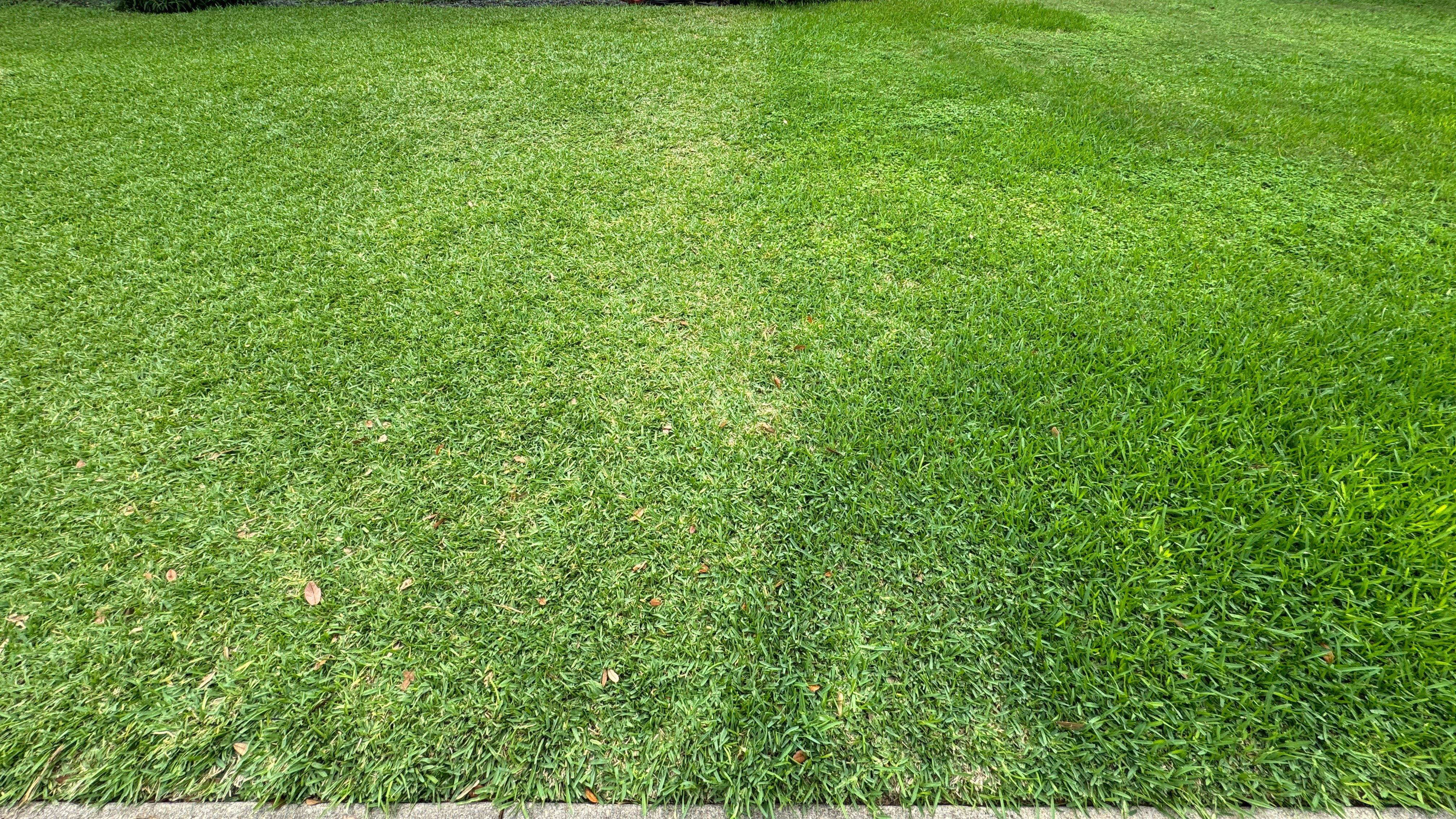
Aside from being an excellent conversation starter—seriously, I’ve become the most popular guy in my neighborhood ever since I got Rover—it’s incredibly quiet. He runs at about 60 decibels which is about the level of a quiet conversation.
Thankfully, I’ve never had to test them, but there are three anti-theft features built into the 450XH:
- If it leaves the geofenced location of my yard (about 100 yards or so) it will start beeping very loudly and won’t stop until it runs out of battery or the pin code is entered
- The included GPS tracking will let me see where it’s at within a distance of just a few feet
- If anyone tries to take it to a dealer to get it reset, once I report it stolen, Husqvarna will automatically alert their system so any dealer would see it’s stolen and refuse to work on it
The Husqvarna Automower Connect app for both iOS and Android is also quite useful for managing Rover. You can use it to make schedules for the mower, adjust the cutting height, and integrate with a few smart services like Google Assistant, Alexa, and IFTTT. There’s also a developer portal where you can create your own automations if you’re into that.
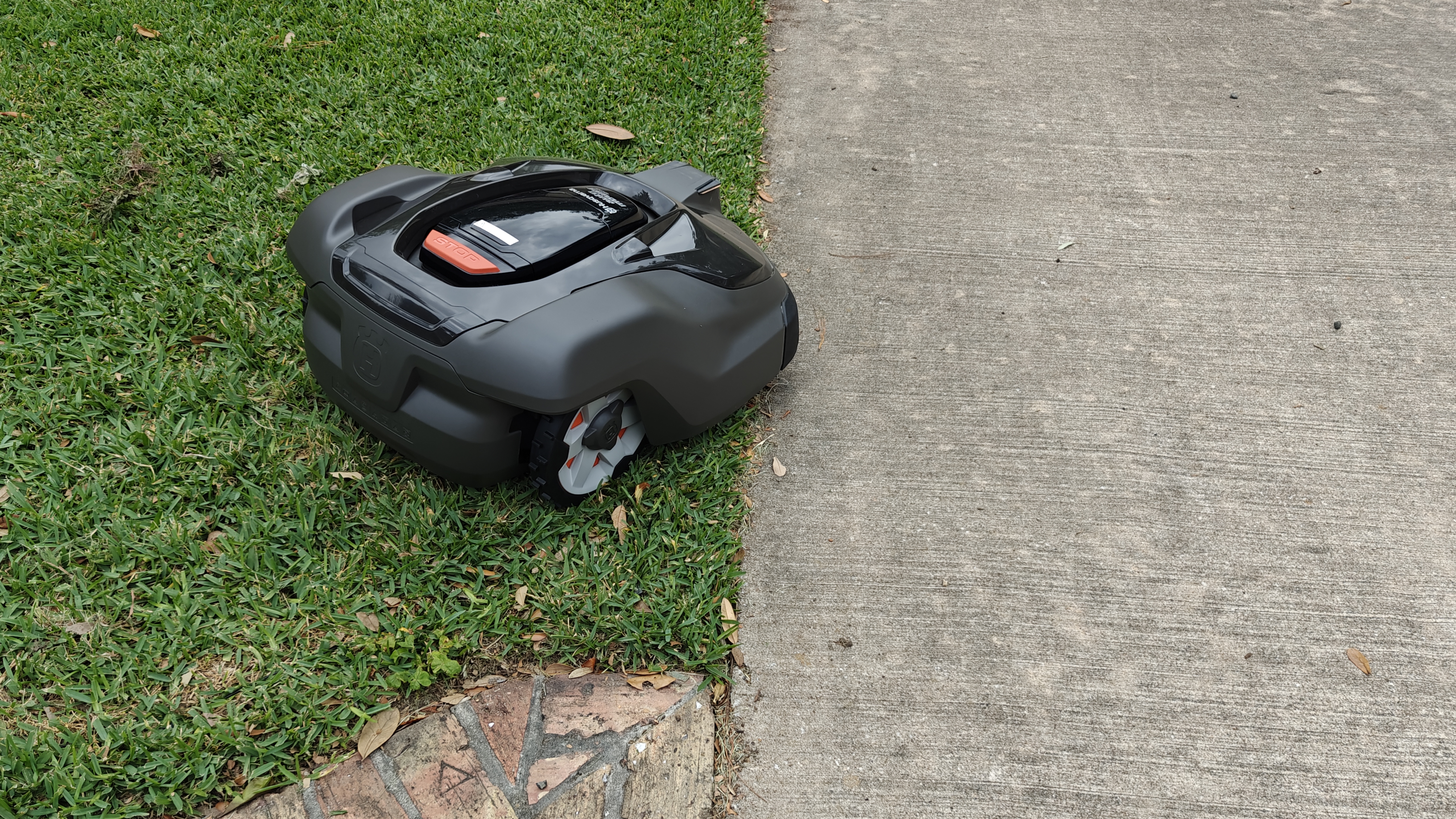
As smart as the 450XH is, it’s not perfect and I’ve run into a couple issues since I set it up. There’s a small metal boundary along the edge of the garden bed where it lives and it’s hard trouble getting over this a few times. I’ve already lowered the boundary once, and even built a little dirt ramp for it, but the back wheels have such heavy traction that it’s actually put a few divots in my grass trying to get over it. I’m willing to acknowledge this has more to do with where and how I’ve set it up, but it’s still annoying.
Rover has also had one of his front wheels roll off my curb leaving him stuck, and he’s even rolled completely off the curb into the street twice now. This is even after I shortened the boundary wire drive-past setting to the smallest possible. My only solution would be to move the entire boundary wire back another few inches, but I was careful about placing it at the recommended distance so I’m a little annoyed that it still gets stuck.
Keep in mind too that with almost any robot mower, while it may do a great job at cutting the grass, you’ll still have to do some work. It can’t edge the yard and because I had to change that boundary wire drive-past setting, some of the very edge of the grass doesn’t get cut so I’ve got to take care of it with my string trimmer. Ultimately, it still saves me quite a bit of time in the end though which is awesome.
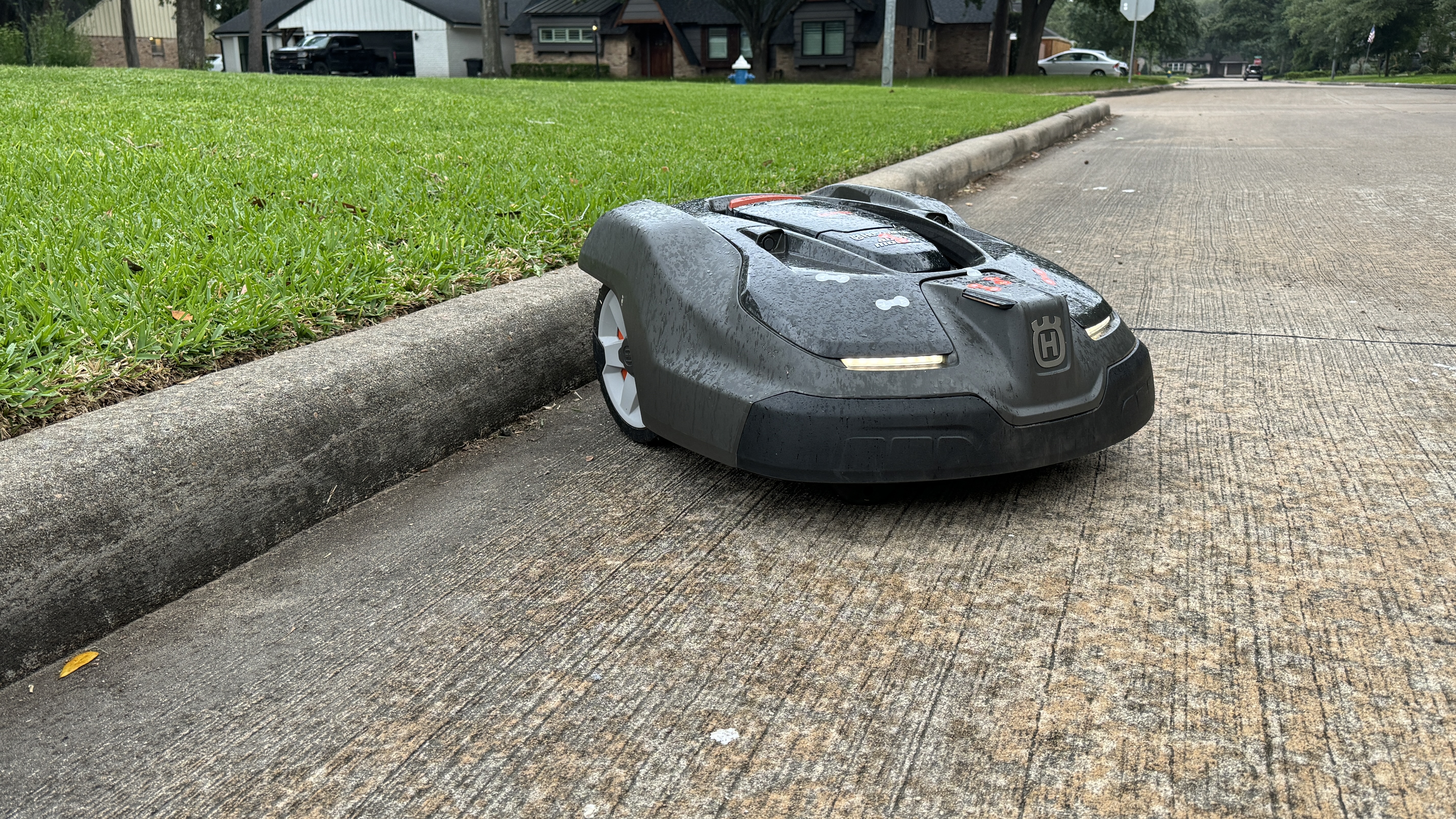
Just be careful with that edging as I definitely snipped my boundary wire accidentally and had to fix it. All you need is a bit of extra wire and a coupler, and I was up and running again in just a few minutes.

Maintenance for Rover is pretty simple. Simply wash off the blades and disk every week or so during the busy cutting season, and replace the blades maybe every other year, depending on how thick your grass grows.
Score: 4.5 out of 5
Husqvarna Automower 450XH: User reviews
Unsurprisingly, most of the reviews I found about the 450XH gave it high praise. Smart Garden Home was impressed the slew of intelligent cutting features and called it an “outstanding robot mower that beats many of the normal mowers out there.”
Out of 44 reviews on the Husqvarna website, the 450XH was rated a 4.8 out of 5 with nearly every user excited about how well it cut and how much time it saved them from not having to mow their lawn all the time.
Should you buy the Husqvarna Automower 450XH?
Buy it if...
Don't buy it if...
How does the Husqvarna Automower 450XH compare?
The 450XH, while being one of the best robot mowers around, is also one of the most expensive. It’s also held back by it’s reliance on boundary wires when most other cutting-edge mowers have eschewed the wires for more high-tech positioning systems. That’s one of the biggest things that makes the Segway Navimow i105N, rated our best overall robot mower, so highly recommended. It only has about one-third of the battery life, but it does a great job cutting the grass and it’s also only about one-third of the price.
If you need something to handle a bigger lawn, the Worx WR150 Landroid is a solid option for a bit less than the 450XH. Plus, if you have quite a few elements in the yard, the Landroid lets you use a digital boundary around them instead of a wire.
For those with lots of hills or a pretty complex lawn, consider the Mammotion Luba AWD 5000. It’s got four large off-road wheels and handles roots and uneven ground with ease. The companion app is a bit tricky, however.
How I tested the Husqvarna Automower 450XH
I set up the Husqvarna Automower 450XH by myself and tested it consistently for several weeks. I had it run for four hours every day and had it adjust the cutting height twice during the testing period. I used the smart integrations for one week which would keep the mower from running when heavy rain was forecasted (I only stopped the integration because my free trial to IFTTT expired and I did not pay for a membership).
Read more about how we test.
First reviewed May 2024







